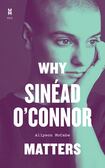
In recent years, a number of works have revisited the maelstrom Sinéad O’Connor found herself in as fame found her. There’s O’Connor’s 2021 memoir, Rememberings, and Kathryn Ferguson’s 2022 documentary, Nothing Compares. At this year’s Choice Music Prize ceremony in Dublin, O’Connor, awarded Best Irish Classic Album for I Do Not Want What I Haven’t Got, was met with a lengthy standing ovation. And now there’s this book, part of a University of Texas Press series of cultural criticism essays on important artists.
For those wondering “whatever happened to Sinéad O’Connor?” (and there will be few in Ireland, where her presence, albums and performances have been sporadic but continuous), McCabe sets out an increasingly widely acknowledged thesis: O’Connor was wronged, she was radical at the right time in the correct way, and just because someone is complex doesn’t mean they should be condemned. This is all true.
Part biography, part reflection on the meaning of O’Connor’s artistry and actions, McCabe traces the achievements and media-generated scandals of O’Connor’s career, and how she consistently sought to beat her own path in a culture that condemned women for veering off the course of sanctioned archetypes.
McCabe rightly cites the free reign male rock stars were and are given compared with women artists labelled as outspoken (read: have a personality beyond a press release), but doesn’t fall into the trap of automatic sainthood for all female artists, rightly calling out Madonna and Miley Cyrus’s careless, cynical and even vindictive targeting of O’Connor.
READ MORE
What’s most powerful is how McCabe draws on her own experience in parallel with O’Connor’s. Perhaps this is O’Connor’s most powerful asset as an artist: she opens up a space for people to see their struggles, their resistance and their trauma, in hers. This is the mode of O’Connor as a spiritual figure, which she is. Some artists are entertainers, but others go deeper, sometimes to shamanic and seer levels.
What one is left reflecting on after reading, is not just how O’Connor’s own victimisation within society, culture and the music industry is an inevitable empathetic proxy for a multitude of similar experiences, but how in music criticism, the desire to seek a sort of pop-cultural vindication of O’Connor so much mirrors the artist’s own pursuit of a multitude of justices.














